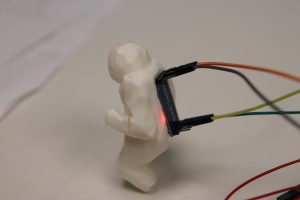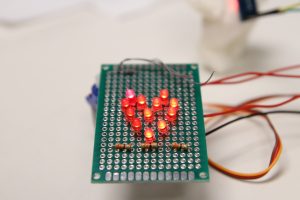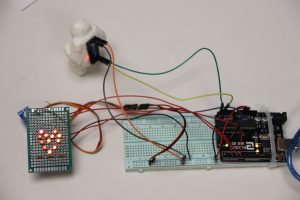The goal of my project was to explore how heart rate can implicitly express emotion. A faster heart rate can mean many different things, from adrenaline, to fear, to excitement. In this specific case, I wanted to see how an increased heart rate can be linked to negative emotions associated with being off-balance.
As you knock the person off-balance, the heart rate increases rapidly. Once the person is back on his feet, the heart rate returns to a steadier, more relaxed rhythm. The heart rate is represented by a string of LEDs in the shape of a heart mounted on a protoboard. The protoboard is mounted to a servo, which moves in rhythm with the heart beat. The person is hand carved from a bar of soap, with an accelerometer embedded in its back.



All details (Arduino sketch, demo video, etc.) can be found here:
https://drive.google.com/drive/folders/0B0yMpI_ZOcoYRzJyZXRWZ3lidkU?usp=sharing
I think the concept for this project is brilliant and beautifully done. It would have been nice to see the servo motor working along with the LEDs but I understand the complication. You mention that the servo does not quite emulate the type of motion that you desired for this concept. I was wondering if you considered turning the motor on its side so that the ‘side to side’ motion could turn into an ‘up and down’ motion that could be a little more controlled than that of the solenoid.
First of all – your person was super adorable. I’m not sure if you were trying to go for astronaut-vibes, but the posture of the person + the cables attached definitely made me think of one.
I thought this was an interesting concept, and your LED display definitely made it easy to understand what was going on. The servo was somewhat necessary given the constraints of the assignment, and was an interesting addition, but I’m not sure if added as much meaning to the project as the LED board or the person itself. Perhaps there’s a balance between the servo’s function and the display’s function that would tie them together a little more?
Overall, *really* good job!